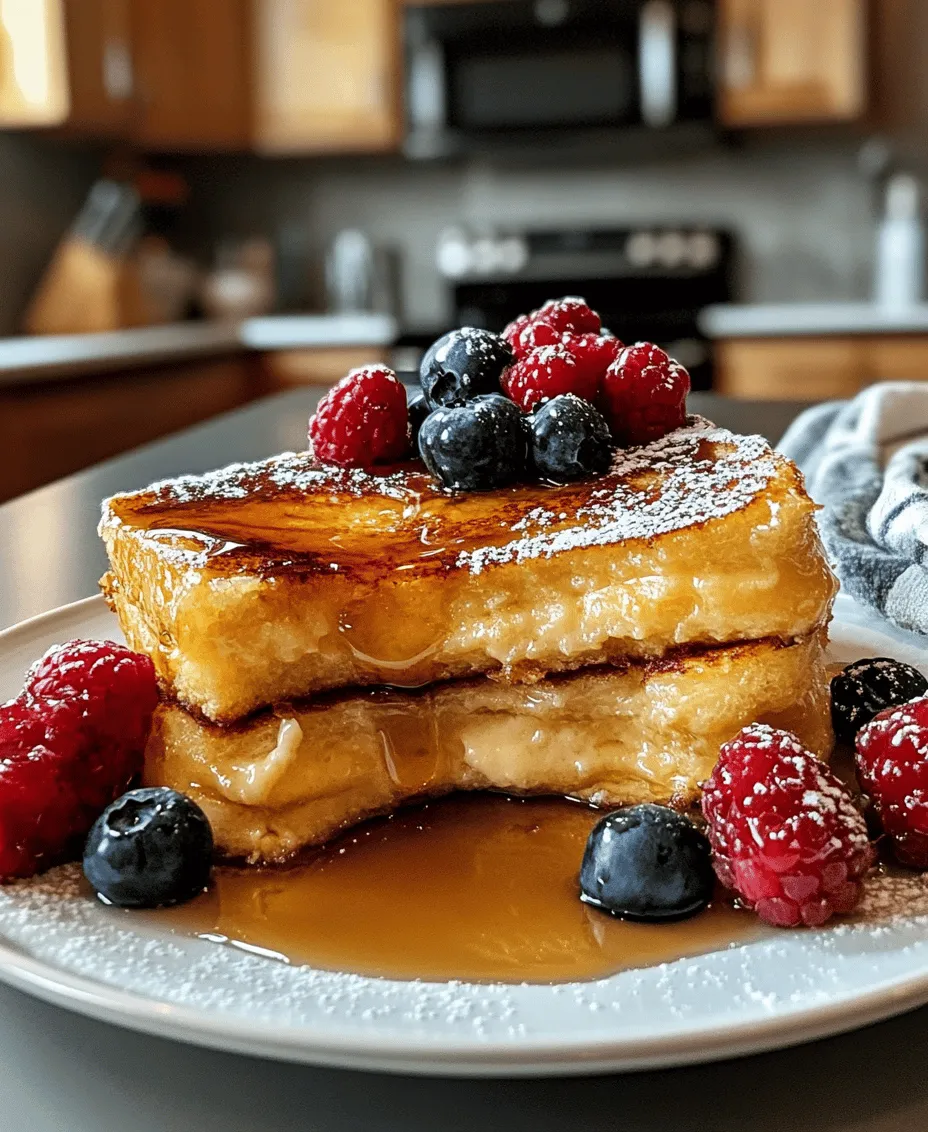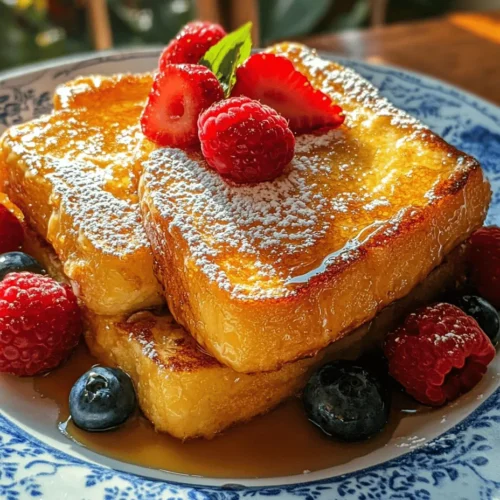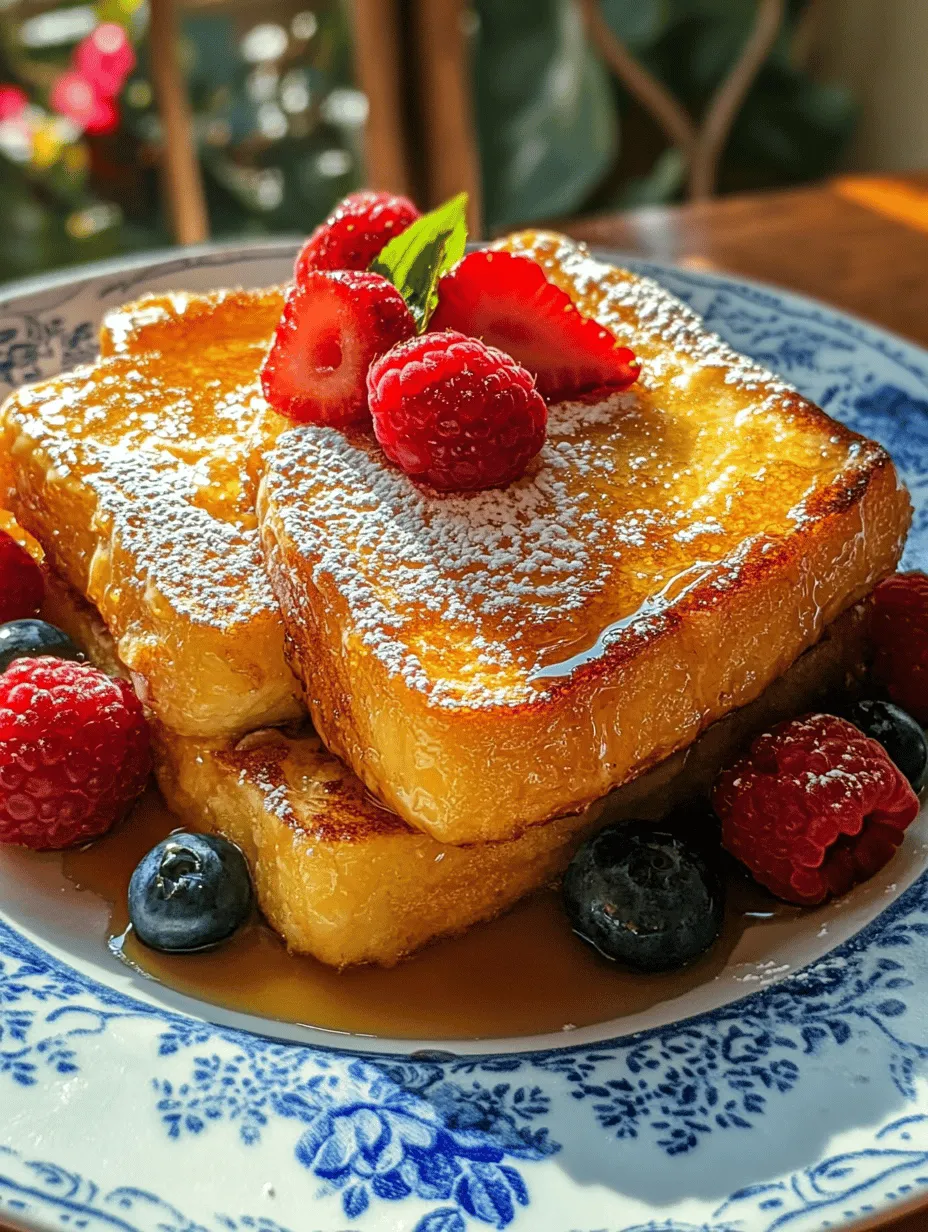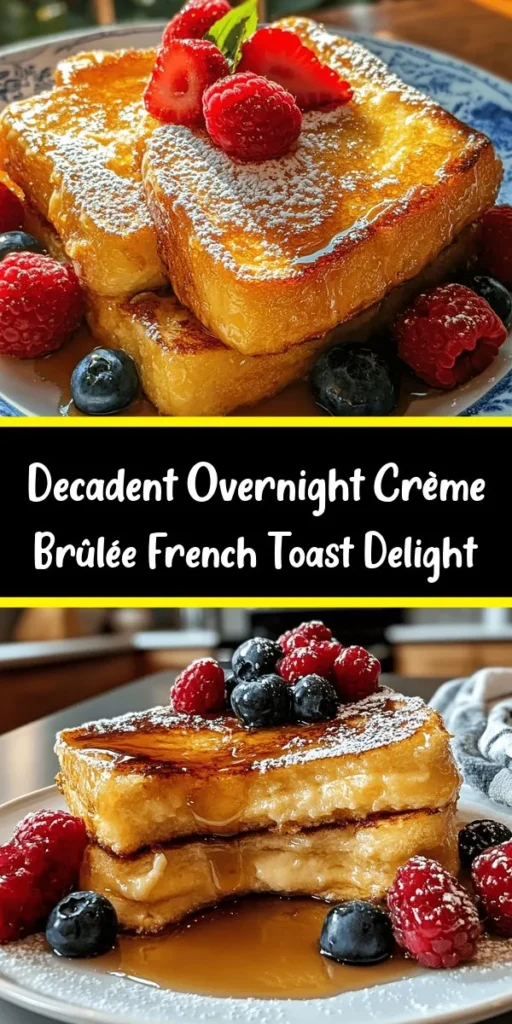Introduction
French toast has long been a beloved breakfast staple, cherished for its simplicity and versatility. From classic maple syrup-drenched slices to innovative savory variations, this dish has made its mark in kitchens around the world. Among the many delightful adaptations, one stands out for its luxurious twist: crème brûlée French toast. This decadent version combines the traditional elements of French toast with the rich custard and caramelized sugar topping of the iconic dessert, crème brûlée.
What makes crème brûlée French toast even more appealing is its convenience. Prepared the night before, this dish allows you to enjoy a gourmet breakfast without the morning rush. Imagine waking up to the enticing aroma of sweet vanilla and cinnamon wafting through your home, all while knowing that your breakfast is ready to be baked to perfection. This overnight preparation not only enhances the flavors but also allows the bread to soak up the creamy custard, resulting in a rich and satisfying breakfast that’s perfect for special occasions or a leisurely weekend brunch.
In this article, we will guide you through the process of creating your very own crème brûlée French toast, from understanding the essential ingredients to the detailed preparation steps that will lead you to breakfast bliss.
Understanding the Ingredients
To create the perfect overnight crème brûlée French toast, selecting the right ingredients is crucial. Here’s a comprehensive overview of what you’ll need:
1. Bread Selection: The Foundation of Flavor
The type of bread you use can significantly affect the texture and flavor of your French toast. For this recipe, brioche or challah bread is recommended. Both breads are enriched with eggs and butter, giving them a soft, tender crumb and a slightly sweet flavor. This richness allows them to absorb the custard mixture beautifully without becoming overly soggy. The result? A luscious, custardy interior that contrasts beautifully with the crispy caramelized topping.
If brioche or challah is not available, you can use other types of bread, but be mindful that the texture may vary. Choose a bread that’s sturdy enough to hold up to soaking without falling apart, such as sourdough or an artisan loaf.
2. The Custard Base: Eggs, Milk, and Cream
The heart of crème brûlée French toast lies in its custard base, made from a blend of eggs, milk, and cream. Eggs provide structure and richness, ensuring that the French toast holds together when cooked. The milk adds creaminess, while the heavy cream enriches the custard, creating a luxurious mouthfeel.
The ratio of these ingredients is essential for achieving the perfect custard texture. Too much milk may result in a watery mixture, while too much cream can make it overly rich. A balanced combination of eggs, milk, and cream ensures a creamy, silky custard that seeps into the bread, resulting in a harmonious flavor profile.
3. Flavorings: The Key to Depth
To elevate the flavor of your crème brûlée French toast, you’ll want to incorporate a few key flavorings:
– Vanilla Extract: A staple in both French toast and crème brûlée, vanilla extract adds warmth and depth to the custard. It enhances the overall flavor, making each bite irresistible.
– Almond Extract: This is an optional but wonderful addition that complements the vanilla beautifully. Almond extract adds a subtle nuttiness and complexity to the custard, taking it to the next level of indulgence.
– Cinnamon: A sprinkle of cinnamon offers a warm, comforting spice that pairs perfectly with the sweetness of the custard and the caramelization process. It’s a classic flavor in breakfast dishes that enhances the overall experience.
– Salt: A pinch of salt is essential in balancing the sweetness and enhancing the natural flavors of the ingredients. It brings out the richness of the custard and complements the caramelized sugar topping.
4. Sugar: Sweetness and Caramelization
Finally, sugar is a critical ingredient in both the custard and the caramelized topping. Granulated sugar is typically used in the custard mixture, adding sweetness that balances the rich flavors of the eggs and cream. After baking, a layer of sugar is sprinkled on top before caramelizing, creating that iconic crunchy crust that makes crème brûlée so distinctive.
Using the right type of sugar is important for achieving the perfect texture. Granulated sugar is ideal for the custard, while superfine sugar can work well for the caramelization process, as it melts quickly and evenly.
Preparation Steps in Detail
Now that we have a clear understanding of the essential ingredients, let’s dive into the preparation steps to create your overnight crème brûlée French toast.
1. Preparing the Baking Dish
The first step in the preparation process is to ready your baking dish. Choosing the right size is important; a 9×13-inch dish is typically ideal for this recipe, as it provides ample space for the bread slices to soak in the custard without overcrowding.
Greasing the Dish: To ensure easy release after baking, it’s crucial to grease the baking dish thoroughly. Use butter or a non-stick cooking spray to coat the bottom and sides of the dish. This step will prevent the French toast from sticking, allowing for a beautiful presentation when serving.
2. Arranging the Bread
Once your dish is prepped, it’s time to arrange the bread. Start by slicing the brioche or challah bread into thick, even slices, about 1 to 1.5 inches in thickness. The thickness of the slices plays a significant role in how well they absorb the custard, so uniformity is key.
Layering Techniques: Begin by laying the first layer of bread slices in the greased baking dish, arranging them snugly together but not overlapping too much. This allows for even soaking. Once the first layer is in place, you can add another layer of bread slices on top, ensuring that every piece is well-positioned to soak up the custard mixture. The goal is to create a layered structure that maximizes the custard absorption while maintaining the integrity of each slice.
3. Crafting the Custard Mixture
With the bread arranged, it’s time to craft the custard mixture that will transform your French toast into a decadent treat.
Whisking Ingredients: In a large mixing bowl, combine the eggs, milk, and cream. Using a whisk, beat the mixture until it’s smooth and well-combined. This step is crucial, as it ensures that the eggs are fully integrated into the milk and cream, creating a uniform custard.
Incorporating Flavorings: Next, add the vanilla extract, almond extract (if using), cinnamon, and salt. Continue whisking until all the ingredients are incorporated and the mixture is creamy. This is where the magic happens; the flavors meld together, creating a delicious custard that will infuse the bread with richness.
Tips for Perfect Custard Texture: For the best results, allow the custard mixture to sit for a few minutes after whisking. This resting period allows the flavors to develop further and ensures a smoother consistency.
4. Pouring and Soaking the Bread
Now that you have a luscious custard mixture, it’s time to pour it over the arranged bread slices.
Even Distribution: Carefully pour the custard evenly over the bread, ensuring that each slice is generously coated. Use a spatula or a spoon to gently press down on the bread to encourage it to soak up the custard. This step is critical; you want to ensure that every piece of bread absorbs the custard mixture so that every bite is flavorful and creamy.
Soaking Time: After pouring the custard, cover the baking dish tightly with plastic wrap or aluminum foil. Place it in the refrigerator and allow it to soak overnight. This overnight soak is what sets crème brûlée French toast apart from traditional recipes, as it allows the bread to fully absorb the custard, resulting in a rich and satisfying breakfast.
By following these initial steps, you are well on your way to creating a show-stopping breakfast that will impress family and friends alike. The combination of creamy custard, sweet caramelization, and the delightful crunch of the top layer will make your overnight crème brûlée French toast a meal to remember. In the next part of this article, we will explore the final baking process and share tips for achieving the perfect finish.

The Science Behind Overnight Soaking for Flavor Absorption
Overnight soaking is a transformative step in preparing Overnight Crème Brûlée French Toast. This technique allows the bread to absorb the rich custard mixture made of eggs, cream, and sugar thoroughly. As the bread soaks, it becomes infused with flavors, resulting in a creamy and decadent texture that is the hallmark of this dish.
The science behind soaking lies in the bread’s structure. Bread is made up of starches and proteins that can absorb liquids. When you let the bread sit in the custard overnight, the starch granules swell and expand, soaking up the custard mixture. This not only enhances the flavor but also ensures that the French toast cooks evenly, creating a moist interior and a perfectly crisp exterior once baked. The longer the bread sits in the mixture, the more flavorful and custardy it becomes, elevating your dish to gourmet status.
Baking Your French Toast
Preheating the Oven
Before you dive into baking your French toast, it’s crucial to preheat your oven to the appropriate temperature. Set it to 350°F (175°C). This step is essential because starting with a hot oven ensures even cooking and browning. Preheating allows the French toast to develop that beautiful golden crust while keeping the inside soft and custardy.
Importance of the Right Temperature for Optimal Baking
Baking at the right temperature significantly affects the final texture and flavor of your Overnight Crème Brûlée French Toast. If the oven is too hot, the outside may brown too quickly, leaving the inside undercooked. Conversely, too low of a temperature can result in a soggy texture rather than the desired crispy exterior.
A temperature of 350°F is ideal because it allows the custard to bake slowly, encouraging a gentle puffing and preventing the dish from becoming overly dry. This balance is key to achieving the perfect French toast.
Baking Technique
Once your oven is preheated, it’s time to bake your French toast. Place the soaked bread slices in a greased baking dish, ensuring they are arranged in a single layer. You may choose to sprinkle some additional sugar on top for extra caramelization during baking. Bake the French toast for about 25-30 minutes, or until the edges are golden brown, and the center looks set.
For a more decadent finish, consider covering the baking dish with foil for the first half of the baking time. This step helps to retain moisture, ensuring the inside stays creamy while the outside crisps up beautifully. Remove the foil for the last 10-15 minutes to achieve that perfect golden crust.
Guidelines for Checking Doneness and Achieving the Right Puffiness
To check for doneness, insert a knife or toothpick into the center of the French toast. If it comes out clean, your dish is ready. The puffiness of your French toast should be noticeable, but it should not be overly inflated. A slight jiggle in the center indicates that it’s still custardy and moist, which is precisely what you want.
If you’re uncertain about the cooking time, it’s better to check a few minutes early. Remember, you can always return it to the oven for a bit longer if needed, but overbaking can lead to a dry French toast that loses its luxurious texture.
Creating the Perfect Crème Brûlée Topping
Explanation of the Caramelization Process
The crowning glory of your Overnight Crème Brûlée French Toast is the delicate, crunchy topping that mimics a traditional crème brûlée. The caramelization process occurs when sugar is heated, causing it to melt and turn into a golden, glass-like crust. This contrast between the creamy French toast and the crispy topping creates an exquisite texture experience.
To prepare the topping, sprinkle an even layer of granulated sugar over the baked French toast just before caramelizing. Ensure the sugar is evenly distributed to achieve a uniform burn.
Using a Kitchen Torch vs. Broiler Method
There are two popular methods to achieve that perfect caramelized topping: using a kitchen torch or the broiler method.
1. Kitchen Torch: This method provides precise control over the caramelization process. Hold the torch about 2-3 inches above the sugar and move it in a circular motion until the sugar melts and forms a golden crust. This technique allows you to see the caramelization in real-time and adjust as necessary.
2. Broiler Method: If you don’t have a kitchen torch, the broiler is a great alternative. Place the baking dish under the broiler for about 2-3 minutes, keeping a close eye to prevent burning. The high heat of the broiler will quickly caramelize the sugar, creating that signature crunchy topping.
Tips for Achieving the Ideal Crunchy Topping
– Use Fine Sugar: Granulated sugar works well, but using superfine sugar can yield a smoother, more even topping.
– Even Layer: Ensure the sugar is spread in a thin, even layer to avoid uneven caramelization.
– Cool Before Caramelizing: Allow the French toast to cool slightly after baking to prevent the custard from bubbling when you apply heat to the sugar.
– Practice Patience: Take your time with the torch or broiler to avoid burning the sugar. A slow, steady approach yields the best results.
Safety Precautions When Caramelizing Sugar
When using a kitchen torch, always prioritize safety. Keep flammable materials away from your work area, and ensure you have a stable surface to work on. Use a heat-resistant surface for the baking dish and be cautious of burns from the flame or hot sugar. If using the broiler, stay close to the oven while caramelizing, as sugar can go from perfectly caramelized to burnt in seconds.
Serving Suggestions
To elevate your Overnight Crème Brûlée French Toast experience, consider these serving suggestions that not only enhance the flavors but also add aesthetic appeal to your brunch table.
1. Garnishing: Fresh fruits such as strawberries, blueberries, or banana slices add a vibrant burst of color and freshness. The natural sweetness of the fruits complements the rich custard beautifully.
2. Maple Syrup: A drizzle of high-quality maple syrup adds an extra layer of sweetness and richness. Consider warming the syrup slightly before serving for an indulgent touch.
3. Whipped Cream: A dollop of freshly whipped cream brings a light, airy contrast to the dense French toast. You can even infuse the whipped cream with vanilla or a hint of cinnamon for added flavor.
4. Beverage Pairing: For a complete brunch experience, serve your French toast with a selection of beverages. Freshly brewed coffee, a creamy latte, or a mimosa made with sparkling wine and orange juice are all excellent choices to complement this indulgent dish.
Nutritional Information
Understanding the nutritional content of your Overnight Crème Brûlée French Toast can enhance your dining experience. Here’s a rough breakdown for one serving, assuming you cut the dish into eight portions:
– Calories: Approximately 350-400 calories
– Carbohydrates: 45-50 grams
– Protein: 8-10 grams
– Fat: 15-20 grams
– Fiber: 1-2 grams
Portion sizes can vary based on personal preferences and dietary needs. While this dish is a delightful indulgence, being mindful of portion sizes can help maintain balance, especially if you’re serving it as part of a larger brunch spread.
Conclusion
Overnight Crème Brûlée French Toast is a luxurious and indulgent dish that combines the rich flavors of crème brûlée with the comforting familiarity of French toast. The process of preparing this dish, from the overnight soaking for flavor absorption to the perfect caramelized topping, is both an art and a science that results in a delightful brunch experience.
This recipe not only showcases the joy of preparing an impressive make-ahead breakfast but also offers the satisfaction of creating a gourmet dish in the comfort of your home. Whether it’s for a special occasion, a festive brunch, or a cozy weekend breakfast, this Overnight Crème Brûlée French Toast is sure to impress. Try this recipe and savor the delightful flavors and textures it offers; your taste buds will thank you for it!



